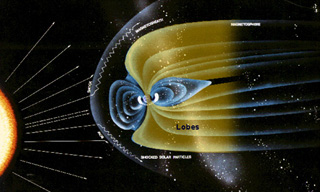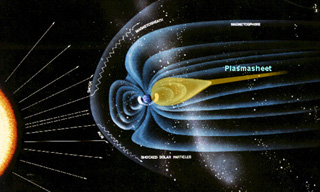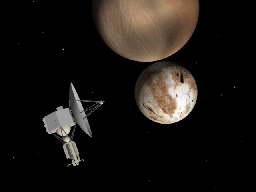This drawing shows the difference between a dipole and a magnetosphere.
Click on image for full size
Image from the AGU Educator's Slide set. Image copyright 1997 by the American Geophysical Union. Further electronic distribution is not allowed.
A Planetary Magnetosphere
A planetary magnetosphere is different from an ordinary dipole. The force of the solar wind, coming from the sun stretches the dipole and creates a nose region in the front of the magnetosphere (facing the sun), and a tail region in the back called a magnetotail.
If it weren't for the solar wind, the field lines of the planetary magnetic field would extend into infinity. But because the solar wind and IMF press upon a planet's magnetic field, and enclose it, the magnetic field is contained within a "cavity" called the magnetosphere. This magnetosphere naturally has a boundary and that boundary is called the magnetopause. The magnetopause can be considered to be the end of a planet's region of influence.
You might also be interested in:

The lobes of the magnetosphere are a vast region of the magnetotail between the magnetopause and the central plasma sheet. The lobes have opposite magnetic direction. In fact, if the plasma sheet didn't
...more
The magnetosheath is the region of space between the bow shock and the magnetopause. The magnetosheath has properties distinct from either the solar wind or the magnetosphere, though the plasma and magnetic
...more
The plasma sheet is simply that, a sheet of plasma that extends down the magnetotail dividing the two lobes of the Earth's magnetic field. The particle density here is about 0.5 cm-3 for both electrons
...more
Dangerous particles are not able to penetrate to the Earth's surface but are forced by the magnetic field to move around the Earth. Particles gain entry through the cusps that are shaped like funnels over
...more
Neptune has three tiny plasmaspheres. The rings of Neptune sweep away much of the particles in the area. Particles enter the plasmasphere from the atmosphere as well as the magnetotail. Mathematical theory
...more
A magnetosphere has many parts, such as the bow shock, magnetosheath, magnetotail, plasmasheet, lobes, plasmasphere, radiation belts and many electric currents. It is composed of charged particles and
...more
AU stands for Astronomical Units. Distances in space are too large to measure in Earth standards like miles or kilometers. For distances too large to measue in AU, we use light years. A light year is the
...more















